I'm using .NET C# XML and LINQ to Update/delete/insert my XML file.
I've got an XML file looks like below (image1) and I would like to inlcude just the 2nd XML file.
The first XML file is the original file and I don't want to touch this file. So I prefer a reference to a 2nd. file (external file) so I can add/remove XML lines there in stead of the Mainf XML file.
But how can do include or merge the 2nd XML (External file) in to the FIRST? I just need to the tags (see RED box) from see in RED box.
<RewriterRule>
<LookFor> </LookFor>
<SendTo> </SendTo>
</RewriterRule>
Question:
1- What do I need to write for code in XML file 1 so my code in XMLfile 2 (external file) is included?
2- How should my XMLfile 2 (external file) look like? In fact I need the tags I think, because I'm reading the XML XDocument xdoc = XDocument.Load(this.Server.MapPath(path));and doing some update/deletes.....

IMAG2 - EXTERNAL FILE
